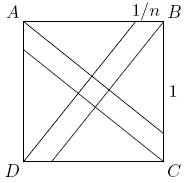1985 AIME Problems/Problem 4
Contents
Problem
A small square is constructed inside a square of area 1 by dividing each side of the unit square into ![]() equal parts, and then connecting the vertices to the division points closest to the opposite vertices. Find the value of
equal parts, and then connecting the vertices to the division points closest to the opposite vertices. Find the value of ![]() if the the area of the small square is exactly
if the the area of the small square is exactly ![]() .
.
Solution
The lines passing through ![]() and
and ![]() divide the square into three parts, two right triangles and a parallelogram. The area of the triangles together is easily seen to be
divide the square into three parts, two right triangles and a parallelogram. The area of the triangles together is easily seen to be ![]() , so the area of the parallelogram is
, so the area of the parallelogram is ![]() . By the Pythagorean Theorem, the base of the parallelogram has length
. By the Pythagorean Theorem, the base of the parallelogram has length  , so the parallelogram has height
, so the parallelogram has height ![]() . But the height of the parallelogram is the side of the little square, so
. But the height of the parallelogram is the side of the little square, so ![]() . Solving this quadratic equation gives
. Solving this quadratic equation gives ![]() .
.
Solution 2
Surrounding the square with area ![]() are
are ![]() right triangles with hypotenuse
right triangles with hypotenuse ![]() (sides of the large square). Thus,
(sides of the large square). Thus, ![]() , where
, where ![]() is the area of the of the 4 triangles.
We can thus use proportions to solve this problem.
is the area of the of the 4 triangles.
We can thus use proportions to solve this problem.
$\begin{eqnarray*} \frac{GF}{BE}=\frac{CG}{CB}\implies \frac{\frac{1}{\sqrt{1985}}}{BE}=\frac{\frac{1}{n}}{1}\implies BE=\frac{n\sqrt{1985}}{1985}$ (Error compiling LaTeX. Unknown error_msg)
Also,
$\begin{eqnarray*} \frac{BE}{1}=\frac{EC}{\frac{n-1}{n}}\implies EC=\frac{\sqrt{1985}}{1985}(n-1)$ (Error compiling LaTeX. Unknown error_msg)
Thus,
$\begin{eqnarray*} 2(BE)(EC)+\frac{1}{1985}=1\\ 2n^{2}-2n+1=1985\\ n(n-1)=992$ (Error compiling LaTeX. Unknown error_msg)











